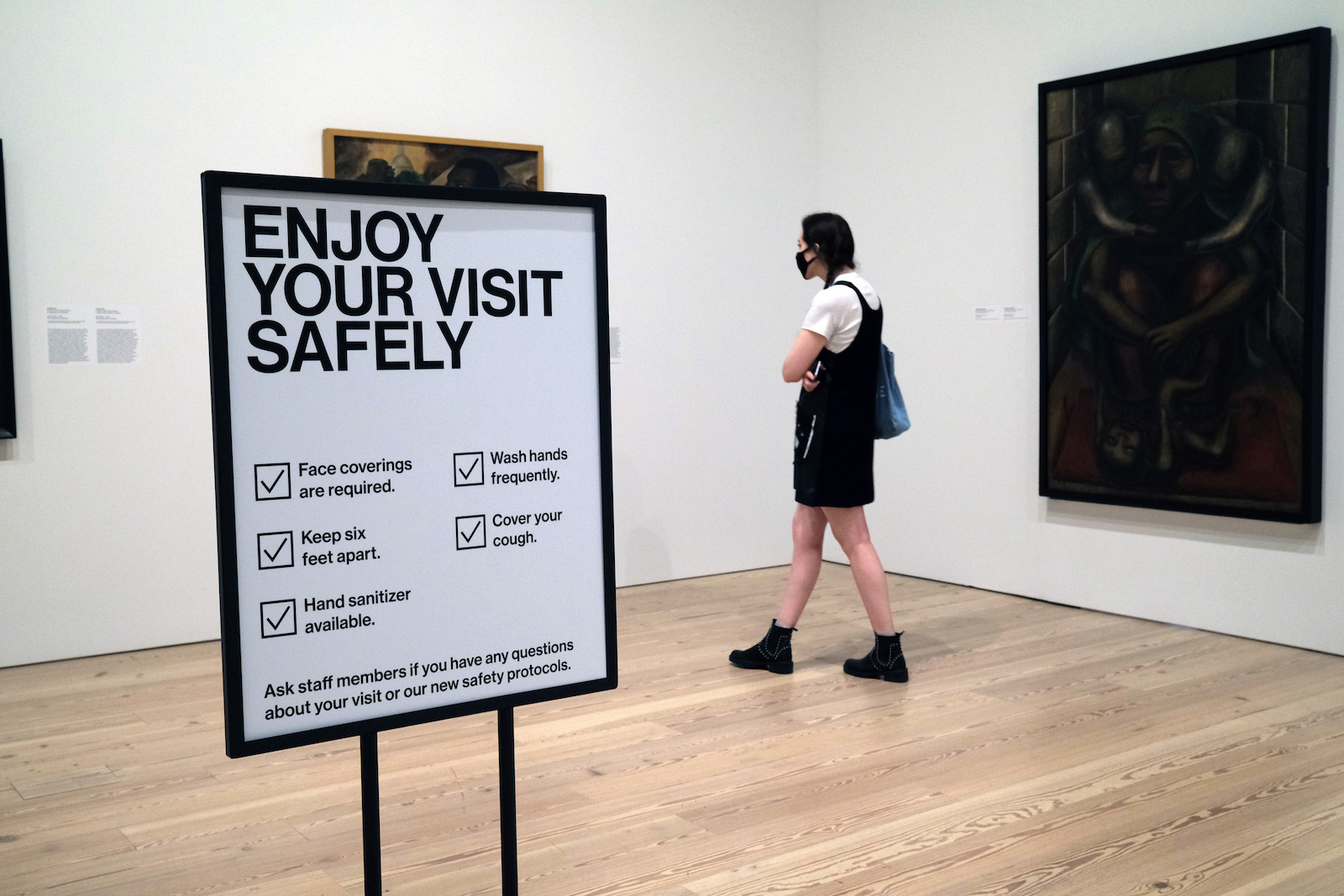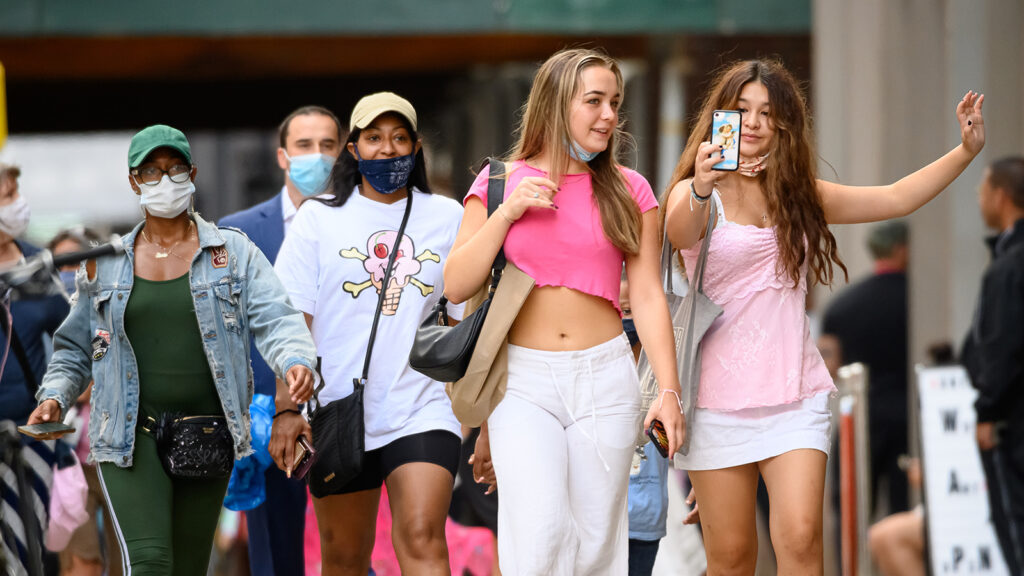
An exhibition at the newly reopened Whitney Museum of American Art on September 3, 2020, in New York City. The museum has new safety guidelines, including health checks and a requirement for visitors to purchase timed tickets in advance.
Photo: Spencer Platt/Getty Images
The global art market is a $67 billion-a-year business and has been growing steadily in recent years, alongside the stock market and the housing market. But unlike some other markets, the COVID-19 pandemic has had less of an economic impact on the art market.
Sarah Thornton is the former chief writer on art for The Economist and the author of Seven Days in the Art World. BRINK began by asking her how well the art market was weathering the pandemic and global recession.
THORNTON: The art market has not been as badly hit by the pandemic as some might expect. A recent report showed that commercial art galleries’ trade was down by nearly 40% in the first half of 2020, and a number of galleries have closed, or merged, or succumbed to takeover.
However, sales on both the primary and secondary art markets are still ticking over. With the pandemic, people are spending so much time in their homes that they want to refresh and improve the art on their walls. The private sale of art is strong in the same way that the residential real estate market is strong. Suburban and rural residences with larger gardens and extra office spaces are trading at a premium.
Pegged to Real Estate
Historically, the art market has been pegged on the real estate market. When people buy a new house, they want to fill it with new art. They’re parallel forms of investment. They are financial (e.g., low interest rates), but they are also highly personal and social investments.
BRINK: Has art traditionally been an investment that people make in times of recession or crisis? Is it seen as a safe harbor for investors?
THORNTON: Yes, but that’s not part of the discourse today in the way it was during the 2008 financial crisis. People are talking about their health and wellness. This is a deeper and more widespread crisis, because it’s a health crisis — not just a financial crisis.
At a time when almost all culture is being digitized, art is a countertrend that honors our bodies. It is something that acts as a physical solace at a time of virtualization. So when people ask, “Do we need art anymore if we can see it on Instagram?” The answer is, “Yes, we need it even more.”
BLM’s Big Impact On the Art Market
BRINK: Have you noticed any interesting trends within the market, e.g., that some parts of the market are getting much more attention or that some are losing popularity?
THORNTON: The resurgence of Black Lives Matter has had a profound effect on people’s perceptions of what will be relevant in art in 20 years. Let’s just say that, for some time, it has been uncool and unsophisticated to have a collection that is made up entirely of white male artists. But, this summer, that shifted into being completely unacceptable — a racist embarrassment.
The white male market is seeing a correction, and the markets of artists who have historically been undervalued are rising.
It is also the case that, overall, white men’s work is overpriced and that work by women and artists of color — whether they’re African American, Native American or Hispanic — has been underpriced. Adding these artists to your collection is a way to update, rejuvenate and make it relevant to our times.
An art collection is more than the sum of its parts. Really serious collectors are busy building up a strong provenance. Building up the reputation of their collection is very important, as it builds up the credibility of all the artists within their collection. A rising tide lifts all boats.
Art Auctions Go Online
BRINK: What about the auction houses themselves? How have they adapted to this new environment?
THORNTON: Well, volume is definitely down for the public sales — we saw that in June and July. Both Christies and Sotheby’s had these peculiar online auctions, with staff in Hong Kong, London and New York doing a live sale, because, of course, it has to be live for bidding purposes.
But being online, they were not really creating the sense of theater and momentum and energy that commands the highest prices. However, they performed decently with lower volume.
From what I’ve heard, auction houses are doing a lot of sales behind the scenes. When the disparity between rich and poor is so wide, private sales feel more comfortable to wealthy people. I don’t think anybody wants to be seen, even if they could be seen, dressed up in an auction room bidding at this time of illness and death, high unemployment and political protests.
So, the auction house specialists might call a client, and say “I know that you were keen to have a Jackson Pollock drip painting of a certain scale. And I’ve got one here from 1955 — it’s in great condition,” so doing the sale privately.
BRINK: Looking forward, how do you see the art market evolving?
THORNTON: I think we’re in the midst of a complete reevaluation of the canon, i.e., the top 50 most important artists. That’s because our sense of what’s important and our sense of the cultural landscape has shifted so dramatically. The art market is not a singular market. It is made up of thousands of artists’ markets, and while one rises, another descends.
We live in a globalized world, despite all these border blockages due to COVID-19. And I think that the stories people are telling themselves about why they’re buying artworks is different now.
And overall, the white male market is seeing a correction, and the markets of artists who have historically been undervalued are rising. The price differential between a woman artist, who is in the history books for her innovations and whose work will stand the test of time, against a lot of living male artists, doing the same old thing, is still shocking.
If you have $10 million to spend and you want a classic collection, right now, I would tell you to buy women artists from the 1960s through 1990s, because you’ll get so much more for your money. And in the long term, they will be part of the canon.






